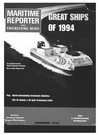
Page 37: of Maritime Reporter Magazine (December 1994)
Read this page in Pdf, Flash or Html5 edition of December 1994 Maritime Reporter Magazine
Norasia Kiel (Continued from page 38) power consumption. • The engine plant: fitted compactly as far aft as possible. • The one-man bridge: fitted out as a ship's operation center. • Reduced loading and discharge costs, optimum ratio of the number of containers to the propulsive power, optimized arrangement of the main engine with its low fuel requirements, and the ship's very good lines reportedly make the ves- sel one of the most economical of its size in the world.
Usually containerships have four to five layers of containers on the hatch covers. On an open top ship, hatch covers no longer need to be stored on land during loading and discharging and the containers no longer need to be lashed to the deck.
The molded depth was increased and the cell guide frames for the containers were raised to the up- permost layer. Of the 11 container layers, eight are in the hold and three jut out topside.
HDW conducted extensive seakeeping tests with a model in order to counter possible dangers caused by breaking seas in heavy weather. In order to prevent water collecting in the holds during mon- soons and to protect the containers from water, the ship was fitted with lightweight rain shelters, each cov- ering one container bay, laid on the drainpipes on the upper edge of the cell guide frames' bulkheads, which lead the water off to the side of the ship.
Norasia Kiel Equipment List
Main engine Mitsubishi
Auxiliary engine Yanmar
Emergency engine Caterpilla
Propeller Lips
Exhaust gas boiler, Switchboard HDW
Steering gear Porsgrunn
Bowthruster KaMeWa
Winch arrangement, Compressors Hatlapa
Centrifugal pumps, Screw pumps Allweiler
Lifts Schmersal
Separators Westfalia
Plate cooler GEA
Fire fighting equipment Norske
Sewage treatment plant Hamworthy
Evaporating plant Serck Como
Incinerator Vesta (Atlas Danemark)
Shaft generator AEG
Transformer Siemens
Gyrocompass,Steering control and
Autopilot Plath, Atlas Elektronik
Batteries Hoppecke
Anemometer Thies
Speed log Atlas Elektronik
Satnav/GPS JRC
Loran-C Furuno
Radar plant, Echosounder Atlas Elektronik
Direction finder Plath
Fire detection Servoteknik
Automation systems STN
Remote level indicator Hoppe
Anchors, Anchor chains Mester
Cargo hold hatches Kvaerne
Windows Bruno Peter
Freefall boat/rescue boat E. Hatecke
Davits Davit-International
Life rafts Deutsche Schlauchbootfabrik
Accommodation ladders Fassmer
Ventilators Witt & Sohn
Air conditioning plant Noske-Kaeser
Refrigerated provision rooms (prefab) Foster
Iron oxide epoxy shop primer Bufa-Bauerle
Paint for outside & inside hull Hempel's
Paint for ballast tanks and empty cells Hempel's
Paint for freshwater tanks Sigma Coatings
Sacrificial anodes Cetema BV
December, 1994 42A
In spite of the shelters, HDW did not reduce the lavish pumping plant prescribed for the ship. The first three holds are fitted with hatch covers. They will be used to carry dangerous cargoes. Two layers of containers can be carried lashed onto these hatch covers. The Panamax breadth allows 11 containers in the hold and 13 over deck in the athwartships lattice. The gaps be- tween the 13 containers stowed next to each other topside amount to only 45mm. Consequently there are T- shaped cell guides and, for easier container handling, insertion guides placed alternately high and low.
The longitudinal subdivision of the open top holds were determined in agreement with the owners so that they offer a suitable ratio of 40- ft. to 20-ft. holds. An important con- sideration in the ship's design was the total height of the container stacks. With no hatch covers, the bottom-most containers bear the entire weight of the stack. Between 260 and 270 tons can be placed in the midships area. This means with 11 layers of containers, a weight of up to 24.5 tons per container is ac- ceptable. The ship is powered by a slow-speed, two-stroke diesel,
Mitsubishi 7UEC 85 LSC engine plant driving a fixed-pitch propel- ler. The engine has a nominal out- put of 27,290 kW (37,100 hp) and a low specific fuel consumption of 165 g/kWh (121 h/hp).
FINCANTIERI
IS BUILDING FOR THE SEA
Fincantieri is the largest and most diversified shipbuilding yard in the
Mediterranean, and one of the largest in Europe.
The operational capability and structures of the oldest and most glorious Italian companies of the sector have met in Fincantieri, during its more than two century long history. An accumulated, improved, and continuously updated wealth of experience acquired through the construction of over 7,000 vessels of all types allows today
Fincantieri to offer technologically advanced answers to all marine operators' requirements, thanks to its organisation structure made up of three Divisions:
Merchant Shipbuilding and Conversions, Naval
Constructions, and
Diesel Engines. (=FinCAnTI€RI
Cantieri Navali Italian! Sp.A.
HEAD OFFICE 34121 Trieste / Italy
Via Genova 1
Tel. (0) 40 3193111
Tlx 461136 FINCTSI
Fax (0) 40 3192305

 36
36

 38
38
